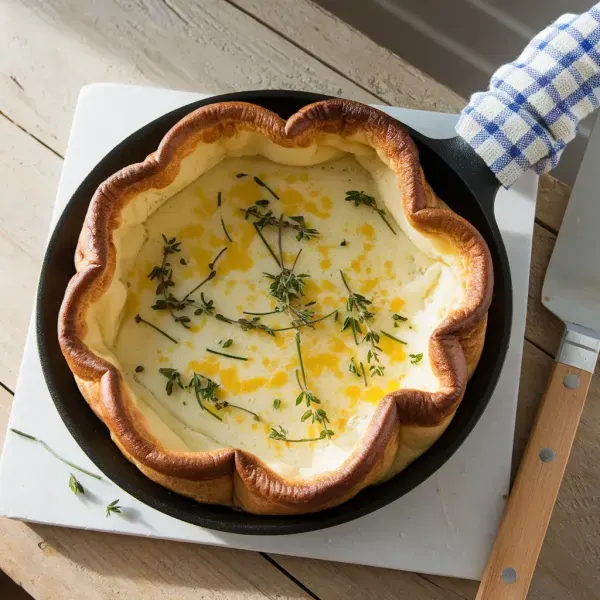
 35 minutes
35 minutesA savory Dutch Baby pancake with a fluffy texture, featuring Parmesan cheese and fresh herbs.


cups
teaspoons
teaspoons
Large Eggs, whisked
each
cups
Unsalted Butter, melted
tablespoons
Flaky Sea Salt
pinches
Fresh Thyme, finely chopped
tablespoons
Chives, finely chopped
tablespoons
1. Preheat Oven and Prepare Batter
Preheat your oven to 425°F. In a large bowl, whisk together the all-purpose flour, kosher salt, and freshly ground black pepper. In a separate bowl, whisk the eggs and whole milk until smooth. Combine the wet and dry ingredients, mixing until no traces of flour remain.
2. Melt Butter and Add Batter to Skillet
Place a 12-inch skillet over medium heat and melt the unsalted butter until it turns a nutty golden color. Swirl the butter to coat the skillet. Pour the batter into the skillet and sprinkle grated Parmesan cheese on top, followed by a pinch of flaky sea salt.
3. Bake the Dutch Baby
Transfer the skillet to the preheated oven. Bake for 20 to 25 minutes, or until the Dutch Baby is puffed and golden brown.
4. Garnish and Serve
Remove the skillet from the oven. Sprinkle the Dutch Baby with finely chopped fresh thyme and chives before serving.
Both the oven and the skillet should be preheated. The skillet should be hot enough to sizzle butter immediately upon contact. This ensures the Dutch Baby begins to puff up the moment it hits the oven, creating a dramatic rise and crisp edges.
Achieving the right consistency of the batter is paramount. It should be smooth and lump-free. To do this, ensure all ingredients are at room temperature before mixing, and use a blender or immersion blender for about 30 seconds to achieve an airy, homogeneous mix.
Use unsalted butter to avoid over-salting the dish, especially since Parmesan is already quite salty. Swirl it around and ensure that it covers the bottom and sides evenly as it melts. This not only prevents sticking but also imparts a rich flavor.
Grate fresh Parmesan finely so it melts smoothly. Distribute it evenly over the batter just before baking. Some can be stirred into the batter, but to maximize the golden-brown top, additionally sprinkle Parmesan on top when it’s halfway through baking.
While it isn't always necessary, letting the batter rest for about 20-30 minutes allows the flour to fully hydrate and the gluten to relax, which can contribute to a more tender texture.




Comments (0)